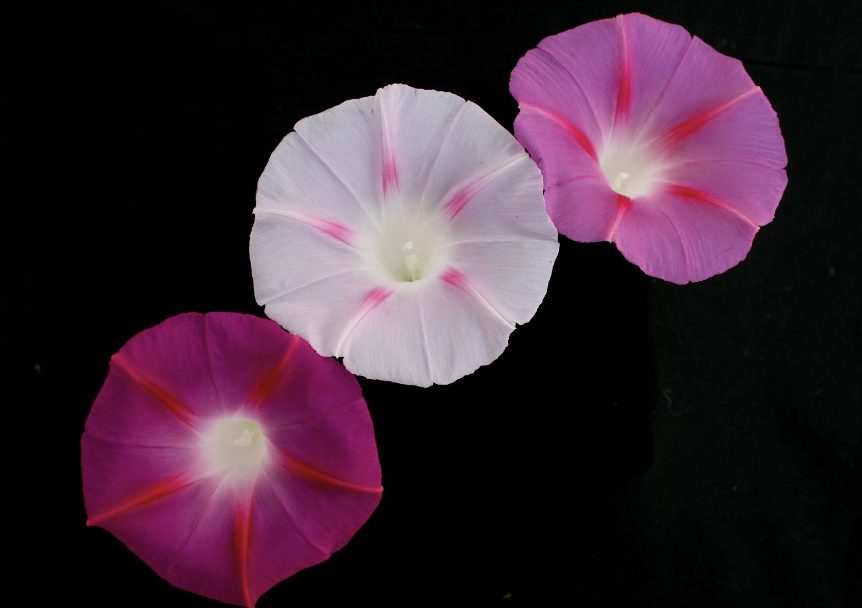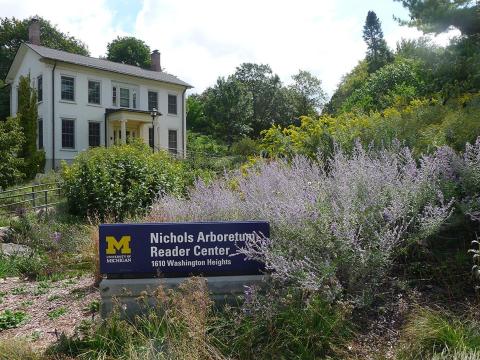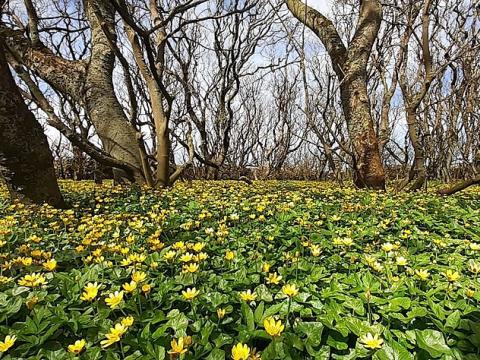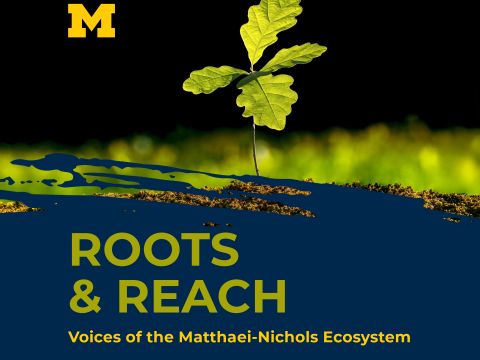
These flowers plucked from different common morning glories demonstrate the diversity of flower color within the species. Image credit: Sasha Bishop, Baucom Lab PhD Candidate.
A new morning glory garden is coming to Matthaei Botanical Gardens. When complete, the garden will show off how diverse even a single group of closely related plants can be while connecting the botanical gardens’ visitors to faculty research.
Morning glories are a group of plants in the genus Ipomoea with 632 species listed in the Kew Plants of the World database. Some scientists say there are as many as 1000 Ipomoea species, and their traits – such as leaf shape and flower color – vary widely. The new garden will encourage visitors to notice and appreciate the group’s wide diversity of species and form, said Anah Soble, a University of Michigan Masters student in the Department of Ecology and Evolutionary Biology who is designing the exhibit. Soble hopes that introducing visitors to this diversity will greatly impact how they perceive their world.
“The more you learn about different species of plants and how traits in plants vary, the more you notice. I think helping people to notice these sorts of things might help them to better appreciate the natural world,” said Soble.
The new exhibit will consist of three plots. One plot will contain several morning glory species that showcase the plant group’s diversity in flower color and leaf shape. In each of the remaining two plots, a single species will take the limelight: the common morning glory in one, and the sweetpotato in the other.
These plant species are familiar to most people as popular ornamental and food plants, respectively, but one potentially overlooked aspect of each plant is that individuals within each species can vary in a number of ways. Common morning glories from the southern portion of their range have lobed leaves, while their northern counterparts have heart-shaped leaves. The leaves can also vary in their hairiness while their flowers come in striped and solid patterns of six different colors: white, deep purple, and shades in between. Sweet potato leaves similarly come in a variety of different shapes.
Such plant diversity is not just about aesthetics; they can correlate with other variable traits important to agriculture. Sweetpotato leaves without lobes tend to have better tubering, and some plants naturally vary in their resistance to herbicides, for instance, which is why scientists like Regina Baucom from the University of Michigan’s Department of Ecology and Evolutionary Biology are so interested in understanding how the traits of individual plants both within and between species vary.
“Variety is the stuff of evolution. When there are fitness differences associated with variation in a particular phenotype, the population can evolve, and we hope that showcasing variation both within and between morning glory species will demonstrate the key role that variation plays in evolution,” said Baucom.
The new morning glory garden is part of a larger “Broader Impacts Garden” coming to Matthaei Botanical Gardens. The exhibit – which will be installed where the medicinal garden is currently located – will feature several subplots that connect Matthaei Botanical Gardens’ visitors to the topics, methods, and results of faculty research projects conducted around the gardens.
“Right now, we have faculty research plots, but we don’t put them on display for the public in a meaningful way . . . Imagine if a kitchen’s staff only shared their work with other cooks,” said Tony Kolenic, the director of Matthaei Botanical Gardens and Nichols Arboretum. The new garden space will bring MBGNA’s faculty research from behind the scenes to the “front of house” for everyone to learn and benefit from.
The various subplots of the Broader Impacts Garden are coming to MBGNA over the next two to three years, but the morning glory garden will be open for visitors to enjoy by early June of this year.
Derek Smith tells stories about science and the natural world for a wide audience. He has written for institutions, blogs, and in magazines as a freelancer, intern, and volunteer. His writing has been featured in the ScienceBites blogs and the Matthaei Botanical Gardens and Nichols Arboretum newsletter.



